Case knife can refer to:
- A large type of table knife, typically stored in a case
- Sheath knife
- The Dutch case-knife, a variety of runner bean
- W. R. Case & Sons Cutlery Co., a maker of knives
Case knife can refer to:
"Mack the Knife" or "The Ballad of Mack the Knife" is a song composed by Kurt Weill with lyrics by Bertolt Brecht for their 1928 music drama The Threepenny Opera. The song has become a popular standard recorded by many artists, including a US and UK number one hit for Bobby Darin in 1959.

A switchblade is a type of knife with a sliding blade contained in the handle which is extended automatically by a spring when a button, lever, or switch on the handle or bolster is activated. Most switchblade designs incorporate a locking blade, in which the blade is locked against closure when the blade is extended to the fully opened position. It is unlocked by a mechanism that allows the blade to be folded and locked in the closed position.

Victorinox is a knife manufacturer and luxury watchmaker based in the town of Ibach, in the Canton of Schwyz, Switzerland. It is well known for its Swiss Army knives. The Swiss Army knives made by Victorinox are made of a proprietary blend steel from Germany and France. Since its acquisition of rival Wenger in 2005, it has become the sole supplier of multi-purpose knives to the Swiss army. It is the biggest manufacturer of pocket knives in the world; in addition, the company licenses its logo for watches, apparel, and travel gear.
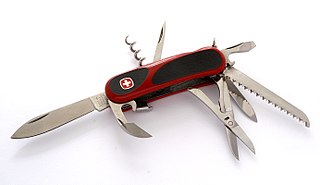
Wenger was one of two companies that have manufactured Swiss Army knives. Based in Delémont, Wenger was acquired by rival Victorinox in 2005. Since 2013, Wenger Swiss Army knives are integrated in the Victorinox collection ; the brand Wenger remains for watches and licensed products.
Shank may refer to:
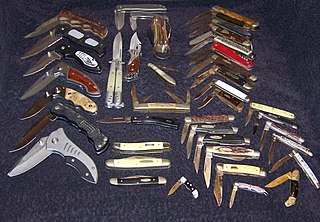
A pocketknife is a foldable knife with one or more blades that fold into the handle. It is also known as a jackknife (jack-knife) or a penknife, though a penknife may also be a specific kind of pocketknife. A typical blade length is 5 to 15 centimetres. Pocketknives are versatile tools, and may be used for anything from opening an envelope, to cutting twine, slicing a piece of fruit to a means of self-defence.
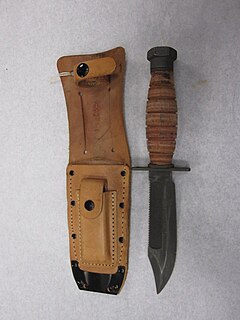
Survival knives are knives intended for survival purposes in a wilderness environment, often in an emergency when the user has lost most of his/her main equipment. Most military aviation units issue some kind of survival knife to their pilots in case their aircraft are shot down behind enemy lines and the crew needs tools to facilitate their survival, escape, and rescue. Survival knives can be used for trapping, skinning, wood cutting, wood carving, and other uses. Hunters, hikers, and outdoor sport enthusiasts use survival knives. Some survival knives are heavy-bladed and thick. Other survival knives are lightweight or fold in order to save weight and bulk as part of a larger survival kit. Their functions often include serving as a hunting knife. Features, such as hollow handles, that could be used as storage space for matches or similar small items, began gaining popularity in the 1980s. Custom or semi-custom makers such as Americans Jimmy Lile, Bo Randall, and Chris Reeve are often credited with inventing those features.

The Fairbairn–Sykes fighting knife is a double-edged fighting knife resembling a dagger or poignard with a foil grip. It was developed by William Ewart Fairbairn and Eric Anthony Sykes in Shanghai based on ideas that the two men had while serving on the Shanghai Municipal Police in China before World War II.
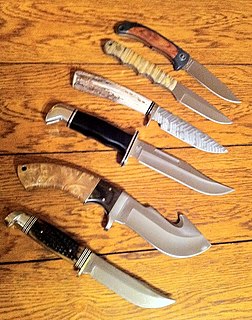
A hunting knife is a knife used during hunting for preparing the game to be used as food: skinning the animal and cutting up the meat. It is different from the hunting dagger which was traditionally used to kill wild game.

A sheath knife is a fixed-bladed knife that fits in a sheath of leather or other material such as nylon or kevlar. The sheath is used to protect the knife and as a carrier. Most importantly, the sheath protects the person carrying the knife from potentially serious injuries that the sharp, unprotected blade could easily cause. To provide sufficient protection, sheaths made of soft materials, such as leather, often have reinforcements, inside or outside of the sheath, made of metal sheet or other suitable materials having sufficient strength.
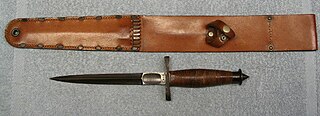
The V-42 stiletto was a stiletto and fighting knife issued during World War II to the First Special Service Force, a joint American/Canadian commando unit.
Knife legislation is defined as the body of statutory law or case law promulgated or enacted by a government or other governing jurisdiction that prohibits, criminalizes, or restricts the otherwise legal manufacture, importation, sale, transfer, possession, transport, or use of knives.

W.R. Case & Sons Cutlery Company is an American manufacturer of traditional pocket knives, fixed blades/sporting knives, kitchen knives, limited edition commemoratives and collectibles. The company originated in Little Valley, New York, around the turn of the 20th century, before relocating to its current home, Bradford, Pennsylvania, in 1905. The company's namesake, William Russell Case, first made knives with his brothers under the name Case Brothers Cutlery Company. His son, John Russell ("Russ") Case, worked as a salesman for his father's company before founding W.R. Case & Sons.
An offensive weapon is a tool made, adapted or intended for the purpose of inflicting physical injury upon another person.

A grapefruit knife is a special type of knife designed specifically for cutting grapefruit. Grapefruit knives are small with a curved serrated blade, designed to hug the curves of the grapefruit. This is used to separate the outer edge of the segments from the rim of the fruit. The term "grapefruit knife" can refer to a type of knife with short, serrated twin blades about 2mm apart, used to separate the sides of each section from the dividing membrane. Some grapefruit knives incorporate both types, a double-sided curved blade on one side and the parallel twin blades on the other. Another type includes an angled tip and double sided serrated blade. When both types are used, the result is an intact-looking fruit with sections which lift out easily - especially if a "grapefruit spoon" is used.

A table knife is an item of cutlery with a single cutting edge, and a blunt end – part of a table setting. Table knives are typically of moderate sharpness only, designed to cut prepared and cooked food.
Twelve Angry Men is a 1954 teleplay by Reginald Rose for the Studio One anthology American television series. Initially staged as a CBS live production on September 20, 1954, the drama was later rewritten for a feature film, 12 Angry Men (1957) and the stage in 1964 under the same title. The episode garnered three Emmy Awards for writer Rose, director Franklin Schaffner and Robert Cummings as Best Actor.

Ross Andrew Parker, from Peterborough, England, UK, was a seventeen-year-old white English male murdered in an unprovoked racially motivated crime. He bled to death after being stabbed, beaten with a hammer, and repeatedly kicked by a gang of British Pakistani men. The incident occurred in Millfield, Peterborough, ten days after the September 11 attacks.
To become a full member of the Mafia or Cosa Nostra – to become a "man of honor" or a "made man" – an aspiring member must take part in an initiation ritual or initiation ceremony. The ceremony involves significant ritual, oaths, blood, and an agreement is made to follow the rules of the Mafia as presented to the inductee. The first known account of the ceremony dates back to 1877 in Sicily.

Ka-Bar is the contemporary popular name for the combat knife first adopted by the United States Marine Corps in November 1942 as the 1219C2 combat knife, and subsequently adopted by the United States Navy as the U.S. Navy utility knife, Mark 2. Ka-Bar is the name of a related knife manufacturing company, Ka-Bar Knives., Inc., of Olean, New York, a subsidiary of the Cutco Corporation.